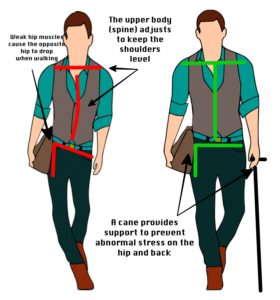In addition to sending electrical impulse from the brain to the muscle (motor nerves), nerves also send electrical impulses from the body to the brain (sensory nerves). These nerves allow us to feel touch, cold and hot, and a pin prick. In addition to that, these nerves tell our brain where our body is in space. Body in space? ![]() Yup, this complex “team” of nerves tell your brain the exact location of every body part. This allows your brain to give the correct motor commands to the body. Still confused on what all this means? No worries, lets use some real life examples to show how this works.
Yup, this complex “team” of nerves tell your brain the exact location of every body part. This allows your brain to give the correct motor commands to the body. Still confused on what all this means? No worries, lets use some real life examples to show how this works.
Imagine if you didn’t not know where your hand was when drinking from a cup. No bueno.
or the exact location of your feet are when walking down stairs. OUCH!
Ok, hopefully now it makes sense. Peripheral nerves are super important and damage to these nerves can be devastating.
What causes a peripheral nerve injury?
Peripheral nerve injuries occur when there is direct trauma to a nerve or a sustained lower force trauma applied to the nerve for a longer duration. Nerve damage can be can result from a compression force, stretching the nerve, or when a nerve is cut or severed.
How is a peripheral nerve damaged?
Compression
Most nerve injuries are caused by a compressive force on the nerve. Compression results in lack of blood to the nerve and causes the tissue to die. A sustained compressive force that is not treated, causes the tissue to die over time. For example, a disc herniation may apply pressure on a nerve and cause progressive weakness over time.
Nerve Stretch (traction injury)
This is caused by an abrupt external force resulting in the immediate loss of function.
Severed Nerve Injury (transection)
Transection involves the complete disruption of neural tissue, with subsequent immediate loss of function and loss of nerve continuity.
What are the symptoms of a peripheral nerve injury?
- Loss of movement
- Loss of sensation
- Pain
- Deformity: muscle atrophy and abnormal postures due to muscle imbalance
- Joint instability: The loss of action of muscles responsible for maintaining alignment or counteracting external forces may result in strains including tendinitis or bursitis, sprains, or potentially more serious injuries
What are the most common locations for a peripheral nerve injury?
The median nerve in the wrist (carpal tunnel syndrome)
Cervical nerve injury: results in pain, numbness, or weakness in the arms
Lumbosacral nerve injury: results in pain, numbness, or weakness in the legs
Thoracic outlet trauma: This occurs when nerves between the collarbone and the first rib are compressed
Peroneal nerve palsy: The peroneal nerve supplies the muscles that lift the foot. This will result in foot drop
How is a peripheral nerve injury diagnosed?
Nerve conduction studies (NCS) and clinical electromyography (EMG), can determine the location, and severity of the nerve damage.
How can physical therapy help to treat a peripheral nerve injury?
Immediately following a nerve injury, there is minimal nerve conduction (electrical charge) to the muscles (supplied by the damaged nerve). Therefore, protecting the surrounding structures is critical in the early stages. As the nerve begins to regenerate, a physical therapist will add strengthening exercises, electrical stimulation, nerve glides, and desensitization techniques.
What is the physical therapy treatment?
- prevention of deformity and stiffness
- balance and walking training: prevent falls and protect against further damage to surrounding body parts or the nerve
- preserve existing function
- pain management
Range of motion (ROM)
Have you ever heard the phrase “If you don’t move it, you lose it.”? Unfortunately, this is a true statement following a nerve injury. Muscle weakness or paralysis can cause elastic structures (tendons and muscles) to become “less elastic”. Range of motion exercises will prevent further injury to tendons, muscles, and joints as the nerve heals and muscles begin to work properly.
Desensitization
When sensory nerves (nerves that send information to the brain) are damaged, normal input to the brain from the damaged nerve is lost. The brain will now get mixed signals from the body to the area of the brain that used to receive input from the injured nerve. This can cause abnormal sensations such as severe pain, burning and tingling. Desensitization is a technique that re-introduces stimulus to the nerve in a gradual manner that will reduce the chances of the unwanted and abnormal sensations.
Nerve Glides
All nerves glide to accommodate the change in length during joint motion. This ensures that the nerve remains tension-free at all times. Nerve gliding (or mobilization) are techniques used to improve the mobility of the nerve.
Joint Protection
Adaptive Equipment Prescription
Adaptive equipment is critical with lower extremity nerve injuries to prevent injury or damage to other body structures
Bracing
An experienced neurologic physical therapist will perform a thorough balance and walking evaluation to make sure a brace does not impede movement recovery.
Electrotherapuetic Treatment
Neuromuscular electrical stimulation (NMES)
NMES is a technique that provides the necessary electrical signal to the muscle that was lost due to the nerve injury. This is used to prevent the muscle from becoming weak while the nerve heals. It is also used to retrain the muscle as the nerve is regenerating.
Call Today and Speak to a Specialist
407-900-0841
Contact Us Today!

Board Certified Neurologic Specialists
Don’t settle for general therapists and treatments by less qualified techs and assistants. 100% of our staff are board certified neurologic Doctors of Physical Therapy









